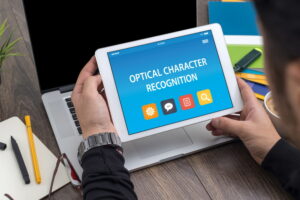
14 Jul How OCR Legal Documents Are Making Law Firms More Efficient

The legal industry generates piles of paperwork each day. Despite living in the digital age, many law firms continue to use paper instead of digitizing their content. The continued use of paper is primarily due to the need to enter large amounts of information when digitizing manually. However, paper is also how many firms feel secure in their documents’ accuracy.
Fortunately, OCR has begun to revolutionize how law firms digitize medical documents. OCR legal documents allow firms to digitize documents in a searchable format without manually entering data.
But what is OCR? More importantly, how has it made law firms more efficient?
What Is OCR?
Optical character recognition, or OCR, is a tool that allows you to turn a scanned text image into a searchable document. You can read, search, and use the document just like you would a hand-typed copy. Legal OCR software takes briefs, case files, and other legal documents and creates easy-to-navigate documents.
How Is the Legal Field Using OCR?
Considering the amount of paperwork that goes through law offices daily, OCR is an excellent tool for promoting efficiency. Here are a few of the most common ways law firms are implementing OCR in their offices.
#1. Creating Searchable Content
Before OCR legal documents, the only way to create a searchable digital document was to enter the text manually. Legal OCR software recognizes text on paper and converts it to searchable text on-screen. As a result, searchability allows you to find a single word or sentence in a fraction of the time it would take to skim each page.
#2. Streamlining Document Retrieval
Document retrieval takes up a lot of time during litigation. In suits where medical record organization is integral to a case, efficient document retrieval software is crucial. Our legal OCR software is an excellent example of how OCR can reduce the time and costs of standard law office tasks.
#3. Reducing Errors
Mistakes happen no matter how much attention to detail a person might have. The likelihood of errors is relatively high when transcribing a paper document into a digital file. OCR legal software allows you to cut that error rate significantly. Instead of hand-writing or typing content, OCR will enable you to copy and paste the information you need easily.
#4. Facilitating Thoroughness
Sometimes, you might be required to highlight all examples of a word or phrase in a document. Manually scanning the document and highlighting sections is an option, albeit with a wide error margin. When your document is text-searchable, you can find, highlight, and bookmark each instance with a few clicks.
#5. Streamlining Navigation
OCR legal documents make it easy to create navigational elements within a text-searchable PDF. Legal OCR software can create bookmarks based on a particular text or text elements. For example, you can search all instances of a specific font and font size, such as section headings. Then, you can bookmark them all to make navigating between sections easy.
#6. Creating Less Waste
A recent survey showed that each lawyer uses 20,000-100,000 sheets of paper yearly. Many of those are duplicate copies of documents sent to clients. When legal OCR software creates a text-searchable record, you can send that document digitally to all interested parties.
#7. Fulfilling eFiling Requirements
Electronically filing, or eFiling, documents is mandatory in most courts. In addition, many courts in the US prefer or require all text documents to be searchable. For example, in Los Angeles, CA, all electronically filed documents must be text-searchable and have a bookmarked table of contents.
#8. Cutting Costs
Using legal OCR software is an efficient way of reducing overhead in your office. It helps cut costs in person-hours, supplies, and services you’d typically need to process documents. With OCR, staff can find information in a fraction of the time. You’ll also pay less for paper and cut back on funds and resources used to send couriers between locations.
#9 Providing Detailed Evidence
Text-searchable documents make it easier to create thorough reports and collections of information. When you’re building a case, having all the necessary information is crucial. OCR makes it easier to gather, organize, and present evidence located in text documents.

The Downside of OCR
Although optical character recognition has streamlined many clerical tasks, it’s not without its downsides.
Resolution Requirements
Higher-resolution documents are easier to scan with OCR legal documents than those that aren’t. If the document you’re using was scanned below 300 DPI, you might have difficulty creating searchable content. In addition, fonts below 10-point are at a higher risk of error than larger sizes.
Paper and Print Quality
Paper that’s dirty or smeared can cause disruptions when OCR attempts to read your document. Also, text that isn’t correctly aligned with the edges of a page could lead to errors or faulty scans.
Missing Information
OCR legal documents aren’t perfect. Sometimes, the software might skip over words or misread them. For that reason, you’ll still want to review each document to confirm accuracy and consistency after each scan.
Implementing OCR
If you’ve chosen to implement OCR in your law firm, you’ll need a few tools to ensure success.
Scanner
A proper document scanner is a requirement for optical character recognition. Some scanners come with software, while others require you to use your own. In either case, your scanner should be capable of scanning documents at a high resolution.
Legal OCR Software
Legal OCR software allows you to turn all PDFs into text-searchable documents. Third-party software you install on each employee’s computer will make it easy to convert documents. This includes documents your firm creates and those sent from outside sources.
Document Management
Text-searchable documents provide a lot of benefits to document management. However, to get the most out of your OCR, you’ll need a proper document management system. Some document management systems have integrated OCR capability, but not all. So, before choosing document management software, ensure it’ll work with OCR.

Conclusion
OCR legal documents help to streamline daily processes in many law firms. Not only does our legal OCR software help cut back on costs, but we have made it easy to find and collect records required for your cases. Using these tools, your firm can get the best results for your clients in less time than before.
Contact us today to learn more about how we can integrate OCR into your firm’s daily operations.



